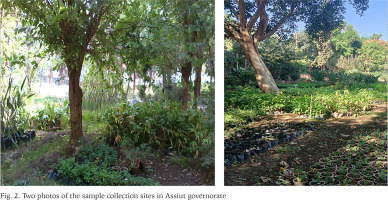INTRODUCTION
Species of terrestrial slugs (Gastropoda: Pulmonata) are among the most significant invertebrate pests of agricultural and horticultural crops. Despite their lack of a shell, making them vulnerable to desiccation (Barua et al. 2021), they flourish in sheltered and moistened habitats such as nurseries, greenhouses and gardens. Many species have been introduced accidentally beyond their natural ranges, being easily transported by human activities such as the plant nursery trade (Britton et al. 2010, Bergey et al. 2014, Ali 2017, Hirano et al. 2019). Many become invasive pests, causing substantial agricultural, medical and economic problems (Rahel 2002), and they may displace native species (USDA APHIS 2010).
Among such invasive pests are slugs in the family Veronicellidae, also known as leatherleaf slugs (Paini et al. 2016). They are flattened, with a large mantle covering the whole of the back (Stocks et al. 2014). They are hermaphrodite, and some, at least, are capable of self-fertilisation. This family contains species that are agriculturally significant, causing serious damage and losses to numerous ornamental and horticultural crops and gardens (Raut 1999, Naranjo-García et al. 2007, Brodie & Barker 2011, Gomes et al. 2013, Capinera & Rodrigues 2015, Ali & Robinson 2020). Containing 23 recognised genera, the family is widely distributed throughout tropical and subtropical regions of the world (Gomes et al. 2010, Hirano et al. 2019). They are distributed across Central and South America, the West Indies, Sub-Saharan Africa, as well as southern and Southeast Asia. Furthermore, they have been introduced to numerous island groups within the Pacific Ocean, along with the Gulf Coast states of the United States (Robinson & Fields 2010).
The veronicellid slug Laevicaulis stuhlmanni (Simroth, 1895) has previously been recorded from Egypt only in Cairo, where it appears to be self-fertilising (Ali 2017, Ali et al. 2022). Its close relative, L. alte, has also been reported from nearby Giza (Ali & Robinson 2020). Here, we report on a second area of occupation, to the south in Assiut Governate, with notes on the slug’s morphology, its plant preferences and its geographical distribution in Egypt.
MATERIAL AND METHODS
STUDY AREA AND SAMPLE COLLECTION
Assiut Governate lies on both banks of the river Nile, in the southern Egypt (Upper Egypt) (Fig. 1). L. stuhlmanni was found at two ornamental plant nurseries within the Governate in April 2018, the Assiut University nursery (27°11′03.6″N, 31°09′49.2″E) and the Al-Muallimeen nursery (27°10′19.9″N, 31°11′19.1″E).
Fig. 1
Veronicellid slugs in Egypt: A – distribution of the veronicellid species in different locations in Egypt; B – the sampling sites of the slug Laevicaulis stuhlmanni in Assiut Governorate. Numbers: 1 – the Nursery Al-Muallimeen; 2 – Ornamental nursery of Assiut University; 3 – Garden in El Zamalek, Cairo; 4 – Abo Rawash, El Saliba district, near the road leading to El Mansouria, Giza
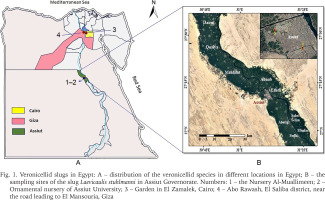
The slugs were collected by hand under and around plant pots, where moisture and shade facilitated aggregations around plant stems, roots and water sources such as irrigation taps. Slugs were collected into labeled boxes and transferred to the laboratory. In addition, observations were made between April 2018 and March 2020 on the distribution of the slugs among different plants. Numbers were recorded, but the slugs were not collected. At the University nursery, other slugs were associated with L. stuhlmanni, such as Ambigolimax valentianus and Deroceras laeve. Snails such as Eobania vermiculata and Monacha obstructa were also found at both locations.
SAMPLE EXAMINATION AND IDENTIFICATION
Forty-seven specimens from both locations were collected into labeled plastic containers with holes for aeration and supplied with fresh lettuce leaves (Lactuca sativa L.) and then transferred to the laboratory of Agricultural Zoology and Nematology Department, Faculty of Agriculture, Al-Azhar University, Assiut Branch. The slugs were drowned in water and then preserved in 75% undenatured ethyl alcohol.
Specimens were sent to D. G. Robinson at USDA APHIS National Malacological Laboratory, and to R. F. Ali at the Faculty of Agriculture, Cairo University. Their identification of specimens was based mainly on the morphology of the reproductive tract. Occurrence records and geographic coordinates of the veronicellid slug species (Family Veronicellidae) in Egypt were obtained from the literature and indicated above and shown in Fig. 1.
In addition, the incidence rate of slugs on particular plant species was studied between April 2018 and March 2020, without collecting them. The number of individuals per sample were recorded.
RESULTS
Laevicaulis stuhlmanni (Simroth, 1895) was found in the two nurseries for ornamental plants in the Assiut district, Assiut governorate, as listed above, in late April 2018. Typical sites are shown in Fig. 2; moist soil, shade, and warmth among the seedlings were the preferable habitats. These records double the number of sites at which veronicellid slugs are known in Egypt. The taxonomic status of this veronicellid slug is as follows:
Class: Gastropoda Cuvier, 1795
Subclass: Pulmonata Cuvier, 1817
Order: Systellommatophora Pilsbry, 1948
Superfamily: Veronicelloidea Gray, 1840
Family: Veronicellidae Gray, 1840
Genus: Laevicaulis Simroth, 1913
Laevicaulis stuhlmanni (Simroth, 1895)
Vaginula stuhlmanni Simroth, 1895 (original combination)
Eleutherocaulis stuhlmanni (Simroth, 1895)
Vaginula schnitzleri Simroth, 1895
Vaginula aequatorialis Simroth, 1896
Vaginula brauni Simroth, 1913
Laevicaulis stuhlmanni aegypti Ali et Robinson, 2017 (nomen nudum)
It is noteworthy that one other veronicellid species, Laevicaulis alte (Férussac, 1822), was also recorded in Giza governorate (Ali & Robinson 2020, 2022).
THE DIAGNOSTIC CHARACTERS OF THE SLUG
The external appearance of the species is shown in Figs 3–4). The average body length of the 13 measured specimens was 4.62±0.69 (SD) cm (range 3.5–5.6 cm with the mantle covering the entire length of the body). The body becomes more elongated when the slug is crawling. The foot is narrow and the pneumostome is not obvious. Additionally, the specimens had a posterior anus and eyes on contractile tentacles. The sensory tentacles are bilobed, and the colour ranges from light brown to dark mottled brown. This result is in accordance with the findings reported by Ali (2017). Eggs were found while collecting samples from the field, during the activity season of the slug. The egg masses are a strip of transparent oval eggs that tend to elongate, tied together with a thin thread, and this strip is coiled, forming the mass.
Figs 3–4
External appearance of a specimen of the slug Laevicaulis stuhlmanni (Simroth, 1895): 3 – dorsal view; 4 – ventral view (a – anus, f – foot, h – hyponotum, hr – head region, k – keel, t – tentacle, tr – tail region). Scale bar 10 mm
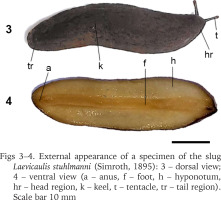
As external characters are similar to those of other veronicellid slugs, and very variable, identification was based on the morphology of the reproductive organs. Diagnostic characters included traits of the male anterior genitalia (penial morphology and the structure of the digitiform gland); also, components of the posterior genitalia and the positioning of the male and female genital pores.
Eight slugs were dissected to examine the genitalia. The male genital pore opens in the anterior part of the body. The anterior male genitalia is composed of two parts, the phallus and the phallic gland that are both enclosed in a light white muscular sheath opens through the genital pore. On the proximal part, there are a number digitiform tubules, numbering around thirteen to fourteen tubules (Fig. 5), as also found by Ali et al. (2022), who found digitiform tubules numbering from ten to seventeen with average 12.5 tubules. The female genital pore is located on the right hyponotum, posterior to the middle of the total length. The posterior genitalia are characterised by a more or less ovate-shaped hermaphroditic gonad (Fig. 6). It has a large convoluted hermaphroditic duct that connects to the albumen gland (Figs 6–7). A relatively long duct leads to the bursa copulatrix (Fig. 8).
Fig. 5
Transverse dissecting view of the male genitalia parts of Laevicaulis stuhlmanni (Simroth, 1895): dt – digitiform tubules (the arrow points to tubule branched into two smaller tubules, which is similar to phallic sheath showed in Ali et al. 2022), pg – phallic gland
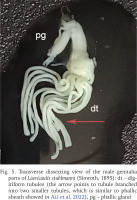
Figs 6–8
Genitalia of Laevicaulis stuhlmanni (Simroth, 1895): 6 – general view (ag – albumen gland, fgp – female genital pore, hd – hermaphroditic duct, hg – hermaphroditic gonad, ov – oviduct, pr – prostatic gland); 7 – closer focus to hd (hermaphroditic duct) and hg (hermaphroditic gonad); 8 – closer focus to bc (bursa copulatrix) and bcd (duct of bursa copulatrix)
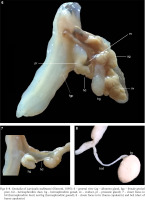
MICROHABITAT DISTRIBUTION
The specimens were collected by hand from the ornamental plant seedlings, the surface of the soil between seedlings, under potted plants, in clay pots, plastic pots, and plastic seedling bags, under the wet wood panels, under fallen leaf litter and on ornamental plant seedlings (Figs 9–12). The slugs were found on various ornamental plants, these are: umbrella plant (Schefflera arboricola), desert petunia (Ruellia brittoniana), horseshoe geranium (Pelargonium zonale), dusty miller (Senecio cineraria), paperflower (Bougainvillea glabra), yucca (Yucca sp.), latania (Latania sp.), kalanchoe (Kalanchoe sp.) (Table 1). The ornamental plant ponds are irrigated daily, and slugs were observed among the seedlings near the water source in the nursery. Consequently, moisture is continuously present. The presence of eggs, feces, or mucus frequently indicates the habitat of a slug.
Table 1
The occurrence rate of the terrestrial slug species Laevicaulis stuhlmanni on various plants in some locations at Assiut governorate, Upper Egypt
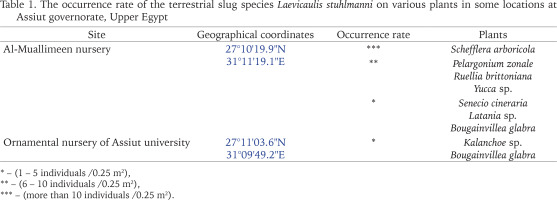
Figs 9–12
Laevicaulis stuhlmanni (Simroth, 1895): 9, 10 – on the ornamental plant seedlings and the surface of the soil between seedlings; 11 – the collected samples of different ages; 12 – external morphology of L. stuhlmanni
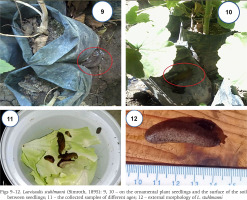
As a result of observing these slugs on plants during the investigation period, the highest incidence of slugs was on umbrella plant, where the average number of slugs exceeded 10 individuals per sample (0.25 m2), while only a few individuals were found on dusty miller, latania, paperflower and kalanchoe plants, where the average number did not exceed five individuals per sample (0.25 m2), during the study period.
DISCUSSION
Lower Egypt has been the subject of numerous studies, in contrast to Upper Egypt, which has received little attention. Therefore, the present study was designed to contribute knowledge about the molluscan fauna in Upper Egypt. In the present investigation, the veronicellid slug species, Laevicaulis stuhlmanni (Simroth, 1895), was documented on ornamental plants within the Assiut governorate, located in Upper Egypt. Some veronicellid slugs have been introduced to Egypt as a result of human activities such as the trade in plant seedlings and the transport of other agricultural products (Ali 2017, Ali & Robinson 2020, 2022). The majority of these species are herbivorous, feeding on a variety of plant species and causing significant damage to seedlings and plants (Das & Parida 2015, Bhavare & Magare 2017, Ali & Robinson 2020). The same species, Laevicaulis stuhlmanni, was reported in a garden in El Zamalek at Cairo governorate for the first time in March and April 2016 on ornamental plants (Ali 2017, Ali et al. 2022). The related slug species Laevicaulis alte (Férussac, 1822) was recorded for the first time in October 2018 in a nursery of ornamental plants in Abo Rawash, El Saliba, El Mansouria, Giza governorate (Ali & Robinson 2020).
Some species of Veronicellidae are significant agricultural and horticultural pests (Rao 1989, Patnaik & Tripathy 2001, Rueda et al. 2002, Brodie & Barker 2012, Bhavare & Magare 2017). Laevicaulis alte has also been recorded as a pest of flower beds in India, where it has been observed feeding on ornamental plants such as balsam, portulaca, marigold, verbena, dahlia, cosmos, narcissus, and lily (Brar & Simwat 1973). Ali & Robinson (2020) reported that the slug species Laevicaulis alte (Férussac, 1822) was recorded in the field on some ornamental plants in Abo Rawash, El Mansouria, Giza governorate. These plants included Nephrolepis spp., Plectranthus scutellarioides, Duranta erecta, Aptenia cordifolia, Kalanchoe marmorata, Aloe nobilis, Tradescantia pallida, Ruellia brittoniana, Senecio mandraliscae, Agave americana, Crassula ovata, Polianthes tuberosa, Tradescantia spathacea and Mangifera indica (seedlings).
The body of L. alte is dark gray to nearly black body with a thin pale median dorsal line (Hirano et al. 2019). However, the genitals must be dissected to confirm the identity of the species. Laevicaulis alte is native to Africa but has been introduced to southern Asia (Marambe et al. 2011, Das & Parida 2015), Australia (Smith & Dartnall 1976), and numerous Pacific Islands (Robinson & Hollingsworth 2009). It remains to be seen if L. stuhlmanni also becomes a significant pest. Care will be needed to identify it accurately.

